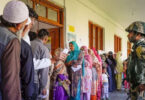By Lal Khan
The rise of religious politics and tendencies with increasingly vicious and belligerent characteristics is wreaking havoc in the South Asian Subcontinent as in many other parts of the world. The sarcastic and witty Indian politician from Bihar, Lalu Prasad Yadav last Sunday taunted Prime Minister Narendra Modi by saying that “earlier people used to fear the lion but now they fear the cow thanks to cow vigilantism across the country.” Lalu Prasad said at a meeting of his Rashtriya Janata Dal (RJD) that due to growing fear for being seen with cows and cattle, the Sonepur cattle fair in Bihar’s Saran district, considered Asia largest cattle fair, had turned into a fair without cattle. He said people were angry with the Modi government in view of its “total failure” in his more than three years rule to improve the lot of the vast majority of the population.
 However, despite the rhetoric of secularism and democracy by the liberal sections of India’s so-called liberal and progressive political parties now in opposition, the crusade of Hindutva fundamentalists with an RSS nominated bigot as the prime minister seems to be in full swing. Sanjay Leela Bhansali’s upcoming film “Padmavati” has unleashed a hysterical frenzy amongst the Hindu fundamentalists who are always on a lookout for any such incident to provoke religious hatred and bloodshed. BJP’s Madhya Pradesh Chief Minister Shivraj Singh Chouhan announced that the film would be banned in his state even if it gets Censor Board clearance.
However, despite the rhetoric of secularism and democracy by the liberal sections of India’s so-called liberal and progressive political parties now in opposition, the crusade of Hindutva fundamentalists with an RSS nominated bigot as the prime minister seems to be in full swing. Sanjay Leela Bhansali’s upcoming film “Padmavati” has unleashed a hysterical frenzy amongst the Hindu fundamentalists who are always on a lookout for any such incident to provoke religious hatred and bloodshed. BJP’s Madhya Pradesh Chief Minister Shivraj Singh Chouhan announced that the film would be banned in his state even if it gets Censor Board clearance.
Except for very few social activists and film industry’s voices, no political party has outrightly come forward to defend Bhansali’s right to produce a work of art. Under the clout of Prime Minister Narendra Modi, who has courted and pampered Hindu chauvinists to instil a frenzied support of his political base, it is becoming a social norm in India that Hindu outrage is stoked by little more than rumours. These bigots perpetrate deadly religious and communal riots and vigilante violence over false claims that Muslims were killing cows sacred to Hindu culture. But this time the film was used to whip up reactionary sentiments mainly amongst the petit-bourgeois masses on a mythological narration of a distant past that can neither be proved nor can it be denied on archival scientific foundations of history.
To mark the 25th anniversary of the Babri Masjid’s demolition, one of the Hindutva outfits Bajrang Dal, the youth wing of the Vishwa Hindu Parishad, has started a recruitment drive among youth that will go on till December 6th. It was the day when vigilantes of these Hindutva outfits demolished the Babri Masjid in Ayodhya in 1992 and is celebrated as “Shaurya Diwas” (bravery day). They are dubbing it as the “silver jubilee” of the Babri Masjid demolition. The Bajrang Dal’s recruitment campaign’s slogans and asserted aims are, “unity of the Hindu nation”, “security of mutts and mandirs”, “protection of gaumata (Cow Mother) ”, “protection of sisters from love jihad”, “to invoke Hinduism’s sentiments” amongst the new generations and the construction of Ram Mandir in Ayodhya. A video footage of its cadre participating in a weapons training drill near the disputed site in Ayodhya has gone viral on social media and television channels. Ever since Modi came to power there have been a terrifying surge of these Hindutva diatribes and violence against the minority religious communities, oppressed castes and the downtrodden masses. Modi’s neoliberal economic crusade has further impoverished the masses. Adventures such as the ‘demonetarisation’ policy hit the already poverty-stricken masses and the lowers sections of the society the most.
The story in Pakistan is not much different either. The Dharna (sit in) of a hard-line Barelvi sect has exposed the regime’s incompetence and indifference of the state. The provocative language and the venom being spewed against the other Islamic sects and vulgar attacks against some of the politicians has been unprecedented. But this is not a one-off thing. Almost daily routine of social and state persecutions of certain minorities, women, and oppressed classes has become a socio-cultural norm. But the aggression is so blatant and the leverage they get from the media, large swaths of political parties, most television channels, TV anchorpersons, columnists and the officials of the crucial state institutions has also increased alarmingly. The socioeconomic ‘terrorism’ against the working classes and the poor is also grotesque. With Zia’s most draconian amendments in the constitution intact despite three decades of his demise says a lot about the ideologies and character of the various ‘democratic’ and secular regimes that came to power in these years. Apart from the religious terror that has ravaged Pakistan the social and cultural despotism of these obscurantist sects is pulverising social life of the ordinary people.
In Bangladesh, the national bourgeois regime of Sheikh Hasina Wajid has been relentlessly using Bengali nationalism and is inversely creating a conflict between the Islamicist fundamentalists and the so-called secular nationalists. It suits her to deflect and undermine the class contradictions that have exacerbated with the crisis of Bangladesh’s capitalism. The national liberation has not been of any respite for the oppressed workers, particularly the women workers, who are forced into drudgery by this ‘nascent’ bourgeois. The reality of this liberation is that the rulers even failed to undo partition and unite East and West Bengal in 1971. The rise of the Islamicists was also the result of the Bengali bourgeois’ failures to ameliorate the oppressed Bengali masses from the misery of exploitation and deprivation.
In Srilanka, the religious conflict and the bloodied civil war between the Tamil Hindus and Singhalese Buddhists’ state has ravaged society. There is now the peace of a cemetery and the wounds cannot be healed in such conditions of a socioeconomic decline and the neoliberal regimes that are worsening the lives of the ordinary Srilankan’s. Burma that used to be the part of United Indian subcontinent before it was craved out by the British imperialists is suffering from a similar religious atrociousness. The ejection and cleansing of the Rohingya Muslims are the latest of episode these prosecutions and cruelty against the religious and the ethnic minorities. Paradoxically this has aggravated under a democratic regime lead by the West’s heroine and Nobel laureate Aang Sung Su Chi.
After the Second World War when these countries got their caricatured independence by carving up of the subcontinent the plight of the oppressed classes has only worsened. The rise of the religious fundamentalists’ forces has been mainly due to the failures of these new national bourgeois states to develop societies. The future of the vast majority of the population is bleak and the youth see no light ahead. In periods when the mass movements are not in the arena hope diminishes. This despair drives the youth particularly those from the middle classes, to look back into the myths of the ‘glorious’ past inoculated in the educational syllabi and mass psychology by the state and corporate media. This ends up into terrorism, bigotry, religious hatred and the reactionary mind-set that we are witnessing. All these regions have had glorious traditions of revolutionary movements and class struggles. The class contradictions shall erupt again and a revolutionary movement will have to end the system and the structures that are devastating one of the richest civilisations on earth.






